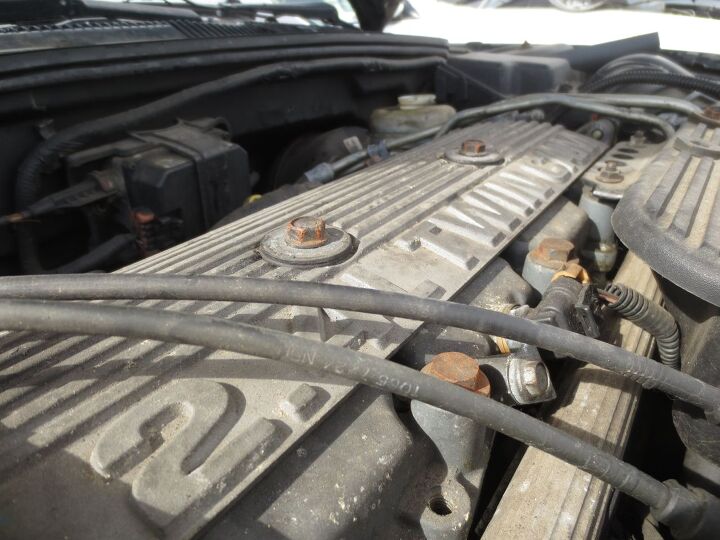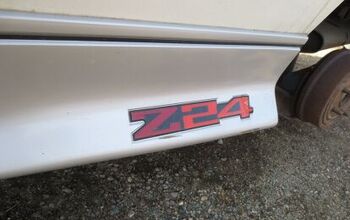Junkyard Find: 1998 Chevrolet Cavalier Z24

GM made many, many Cavaliers during the model’s 23-year production run, and these days the mid-to-late-90s models are most common in high-turnover wrecking yards. Mostly I don’t photograph Cavaliers for this series, though I did shoot this ’90 Cavalier RS last year. However, I do think that cars powered by the Oldsmobile Quad 4 engine are worthy of Junkyard Find status— we’ve seen this ’90 Cutlass Calais International Series and this ’93 Achieva SCX so far— and the Cavalier Z24 was the last GM car to get the Quad 4, so let’s take a look at this ’98 that I spotted in Denver last week.
For the 1996 model year, GM had come up with the LD9 Twin Cam 2.4 version of the Quad 4, which featured balance shafts plus a torque-enhancing stroke-increase/bore-decrease treatment. Power was 150 horses, which was pretty good for a car this small.
The late 1990s were all about body-colored plastic cladding and trim.
The Getrag 5-speed is pretty rare in these things, so I was disappointed to find the usual automatic shifter inside.

Murilee Martin is the pen name of Phil Greden, a writer who has lived in Minnesota, California, Georgia and (now) Colorado. He has toiled at copywriting, technical writing, junkmail writing, fiction writing and now automotive writing. He has owned many terrible vehicles and some good ones. He spends a great deal of time in self-service junkyards. These days, he writes for publications including Autoweek, Autoblog, Hagerty, The Truth About Cars and Capital One.
More by Murilee Martin
Latest Car Reviews
Read moreLatest Product Reviews
Read moreRecent Comments
- W Conrad I'm not afraid of them, but they aren't needed for everyone or everywhere. Long haul and highway driving sure, but in the city, nope.
- Jalop1991 In a manner similar to PHEV being the correct answer, I declare RPVs to be the correct answer here.We're doing it with certain aircraft; why not with cars on the ground, using hardware and tools like Telsa's "FSD" or GM's "SuperCruise" as the base?Take the local Uber driver out of the car, and put him in a professional centralized environment from where he drives me around. The system and the individual car can have awareness as well as gates, but he's responsible for the driving.Put the tech into my car, and let me buy it as needed. I need someone else to drive me home; hit the button and voila, I've hired a driver for the moment. I don't want to drive 11 hours to my vacation spot; hire the remote pilot for that. When I get there, I have my car and he's still at his normal location, piloting cars for other people.The system would allow for driver rest period, like what's required for truckers, so I might end up with multiple people driving me to the coast. I don't care. And they don't have to be physically with me, therefore they can be way cheaper.Charge taxi-type per-mile rates. For long drives, offer per-trip rates. Offer subscriptions, including miles/hours. Whatever.(And for grins, dress the remote pilots all as Johnnie.)Start this out with big rigs. Take the trucker away from the long haul driving, and let him be there for emergencies and the short haul parts of the trip.And in a manner similar to PHEVs being discredited, I fully expect to be razzed for this brilliant idea (not unlike how Alan Kay wasn't recognized until many many years later for his Dynabook vision).
- B-BodyBuick84 Not afraid of AV's as I highly doubt they will ever be %100 viable for our roads. Stop-and-go downtown city or rush hour highway traffic? I can see that, but otherwise there's simply too many variables. Bad weather conditions, faded road lines or markings, reflective surfaces with glare, etc. There's also the issue of cultural norms. About a decade ago there was actually an online test called 'The Morality Machine' one could do online where you were in control of an AV and choose what action to take when a crash was inevitable. I think something like 2.5 million people across the world participated? For example, do you hit and most likely kill the elderly couple strolling across the crosswalk or crash the vehicle into a cement barrier and almost certainly cause the death of the vehicle occupants? What if it's a parent and child? In N. America 98% of people choose to hit the elderly couple and save themselves while in Asia, the exact opposite happened where 98% choose to hit the parent and child. Why? Cultural differences. Asia puts a lot of emphasis on respecting their elderly while N. America has a culture of 'save/ protect the children'. Are these AV's going to respect that culture? Is a VW Jetta or Buick Envision AV going to have different programming depending on whether it's sold in Canada or Taiwan? how's that going to effect legislation and legal battles when a crash inevitibly does happen? These are the true barriers to mass AV adoption, and in the 10 years since that test came out, there has been zero answers or progress on this matter. So no, I'm not afraid of AV's simply because with the exception of a few specific situations, most avenues are going to prove to be a dead-end for automakers.
- Mike Bradley Autonomous cars were developed in Silicon Valley. For new products there, the standard business plan is to put a barely-functioning product on the market right away and wait for the early-adopter customers to find the flaws. That's exactly what's happened. Detroit's plan is pretty much the opposite, but Detroit isn't developing this product. That's why dealers, for instance, haven't been trained in the cars.
- Dartman https://apnews.com/article/artificial-intelligence-fighter-jets-air-force-6a1100c96a73ca9b7f41cbd6a2753fdaAutonomous/Ai is here now. The question is implementation and acceptance.

















































Comments
Join the conversation
Well, their reputation has improved in death. They seem to have cachet as a cheap, serviceable, presentable, inexpensive to repair used car these days. That means a lot in an economic depression. I stayed at an Air BNB place with two young school teachers in a resort town. They had a perfectly acceptable Cavalier. Worth Maybe 3K. They had no rent payment thanks to their BNB operation, the Cavalier which was cheaper than owning a decent bike. I figured they were banking at least 40K per year.
J cars are dying off left and right, hauled to scrap nowadays. Their time has passed. Bu-Bye, as 'collectible' as old Vegas and Chevettes, And yes, I've driven one. Borrowed a '99 from friend for a week and it was like driving our family's '75 Skyhawk, when it was 10 y/o! Already felt like a 10 year old car, in 2004. Buddy unloaded it on step sister and it got impounded. Current GM compacts are world's better!